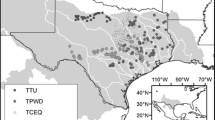Abstract
We formulated a species distribution model (SDM) for the amphidromous fish Sicyopterus japonicus on the basis of presence/absence data and confirmed its performance at various population densities. The best-fit SDM selected several environmental factors, including water depth and velocity, and performed validated prediction of presence/absence of various densities. The predicted probability of occurrence was positively correlated with the observed density. The density was positively related to habitat occupancy, suggesting that this species occupied a wide range of habitats under high densities, but only optimal habitat under low densities. Therefore, the threshold value for predicting presence/absence increased with decreasing densities.


Similar content being viewed by others
References
Akaike H (1974) A new look at the statistical model identification. IEEE Trans Automat Control 19:716–723
Akihito, Sakamoto K, Ikeda Y, Aizawa M (2013) Sicyopterus japonicus. In: Nakabo (ed) Fishes of Japan with pictorial keys to the species, 3rd edition. Tokai University Press, Kanagawa, p. 1408
Akobeng AK (2007) Understanding diagnostic tests 3: receiver operating characteristic curves. Acta Paediatrica 96:644–647
Dôtu Y, Mito S (1955) Life history of a gobioid fish, Sicydium japonicum TANAKA. Sci Bull Fac Agr Kyushu Univ 15:213–221
Frisk MG, Duplisea DE, Trenkel VM (2011) Exploring the abundance-occupancy relationships for the Georges Bank finfish and shellfish community from 1963 to 2006. Ecol Appl 21:227–240
Fukuda S, De Baets B, Mouton AM, Waegeman W, Nakajima J, Mukai T, Hiramatsu K, Onikura N (2011) Effect of model formulation on the optimization of a genetic Takagi-Sugeno fuzzy system for fish habitat suitability evaluation. Ecol Model 222:1401–1413
Fukuda S, Mouton AM, De Baets B (2012) Abundance versus presence/absence data for modelling fish habitat preference with a genetic Takagi-Sugeno fuzzy system. Environ Monit Assess 184:6159–6171
Gaston KJ, Blackburn TM, Greenwood JJD, Gregory RD, Quinn RM, Lawton JH (2000) Abundance-occupancy relationships. J Appl Ecol 37 (Suppl 1):39–59
Guisan A, Zimmermann NE (2000) Predictive habitat distribution models in ecology. Ecol Model 135:147–186
Gutiérrez D, Harcourt J, Díez SB, Illán JG, Wilson RJ (2013) Models of presence-absence estimate abundance as well as (or even better than) models of abundance: the case of the butterfly Parnassius apollo. Landscape Ecol 28:401–413
Hayashi K, Kim EJ, Onikura N (2013) Growth and habitat use of the Chinese false gudgeon, Abbottina rivularis, in an irrigation channel near the Ushizu River, northern Kyushu Island, Japan. Ichthyol Res doi:10.1007/s10228-013-0335-1
Iguchi K, Matsuura K, McNyset KM, Peterson AT, Scachetti-Pereira R, Powers KA, Vieglais DA, Wiley EO, Yodo T (2004) Predicting invasions of north American basses in Japan using native range data a genetic algorithm. Trans Am Fish Soc 133:845–854
Kano Y, Kawaguchi Y, Yamashita T, Shimatani Y (2010) Distribution of the oriental weatherloach, Misgurnus anguillicaudatus, in paddy fields and its implications for conservation in Sado Island, Japan. Ichthyol Res 57:180–188
Katano O, Nakamura T, Abe S, Yamamoto S, Baba Y (2006) Comparison of fish communities between above- and below-dam sections of small streams; barrier effect to diadromous fishes. J Fish Biol 68:767–782
Liu C, Berry PM, Dawson TP, Pearson RG (2005) Selecting thresholds of occurrence in the prediction of species distribution. Ecography 28:385–393
McCullagh P, Nelder J (1989) Generalized linear models, 2nd edition. Chapman & Hall, London
Ministry of Land, Infrastructure and Transport, Japan (2012) Technical criteria for river work. http://www.mlit.go.jp/river/shishin_guideline/gijutsu/gijutsukijunn/index2.html. Accessed 11 March 2013
Onikura N, Nakajima J (2013) Age, growth and habitat use of the topmouth gudgeon, Pseudorasbora parva in irrigation ditches on northwestern Kyushu Island, Japan. J Appl Ichthyol 29:186–172
Onikura N, Nakajima J, Kouno H, Sugimoto Y, Kaneto J (2009) Habitat use in irrigation channels by the golden venus chub (Hemigrammocypris rasborella) at different growth stages. Zool Sci 26:375–381
Onikura N, Nakajima J, Miyake T, Kawamura K, Fukuda S (2012) Predicting the distribution of seven bitterling species inhabiting northern Kyushu Island, Japan. Ichthyol Res 59:24–133
Sato M, Kawaguchi Y, Yamanaka H, Okunaka T, Nakajima J, Mitani Y, Shimatani Y, Mukai T, Onikura N (2010) Predicting the spatial distribution of the invasive piscivorous chub (Opsariichthys uncirostris uncirostris) in the irrigation ditches of Kyushu, Japan: a tool for the risk management of biological invasions. Biol Invasions 12:3677–3686
Takita T, Chikamoto H (1994) Distribution and life history of Trachidermus fasciatus in rivers around Ariake Sound, Kyushu, Japan. Jpn J Ichthyol 41:123–129
Watanabe S (2012) Kuroshio Current transports munk goby, Sicyopterus japonicus. In: Matsuura K (ed) Fishes of the Black Current. Tokai University Press, Kanagawa, pp 113–141
Webb TJ, Dulvy NK, Jennings S, Polunin NVC (2011) The birds and the seas: body size reconciles differences in the abundance-occupancy relationship across marine and terrestrial vertebrates. OIKOS 120:537–549
Acknowledgments
The authors wish to thank Mr. A. Koyama, Y. Okamoto, K. Hayashi, T. Ihara, H. Oura, K. Ukai, T. Ohata, and Y. Shinada (Kyushu University) for their generous research support. The authors also thank two anonymous reviewers for providing useful comments. A part of this study was conducted in association with the Gokase Group of the Academic Research Group of River Ecosystem, which was supported by the Foundation for Riverfront Improvement and Restoration, Tokyo, Japan. The cost of publication was supported in part by the Research Grant for Young Investigators of the Faculty of Agriculture, Kyushu University.
Author information
Authors and Affiliations
Corresponding author
About this article
Cite this article
Onikura, N., Inui, R., Oikawa, S. et al. Performance of a species distribution model based on presence/absence for various population sizes in the amphidromous fish species Sicyopterus japonicus . Ichthyol Res 61, 90–96 (2014). https://doi.org/10.1007/s10228-013-0375-6
Received:
Revised:
Accepted:
Published:
Issue Date:
DOI: https://doi.org/10.1007/s10228-013-0375-6




